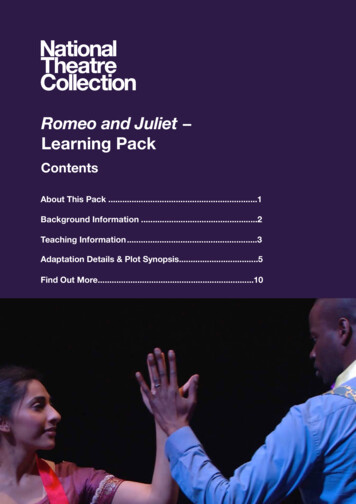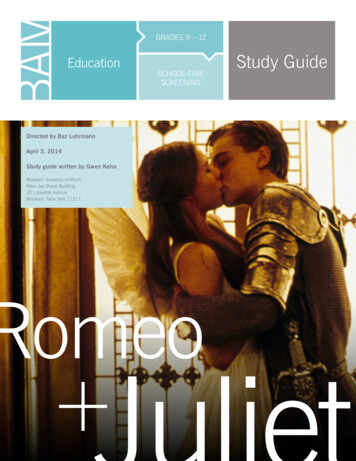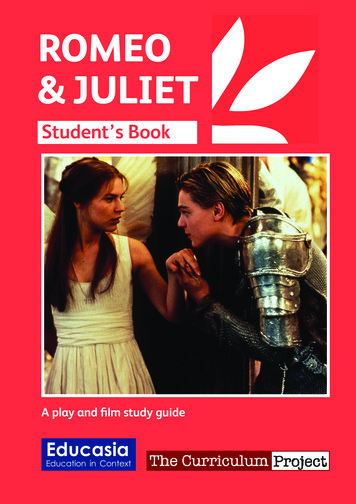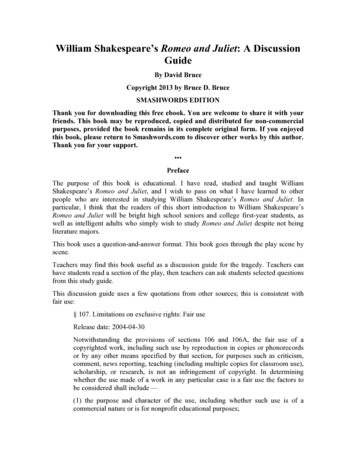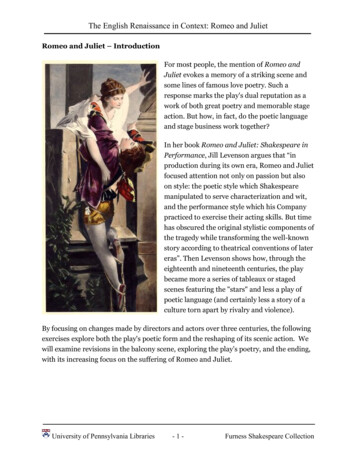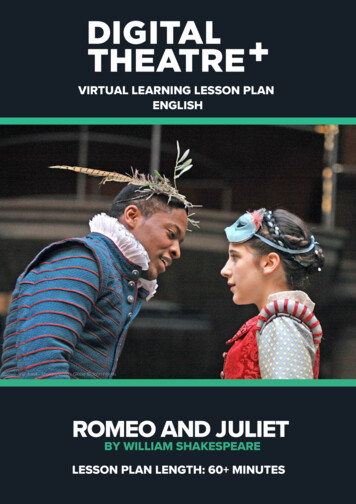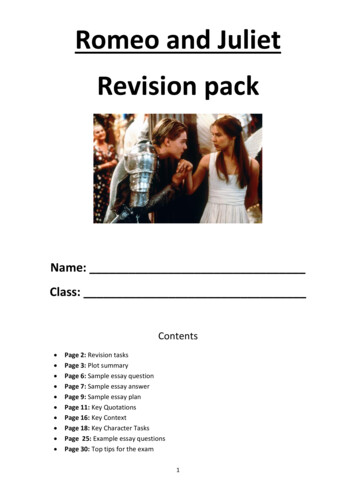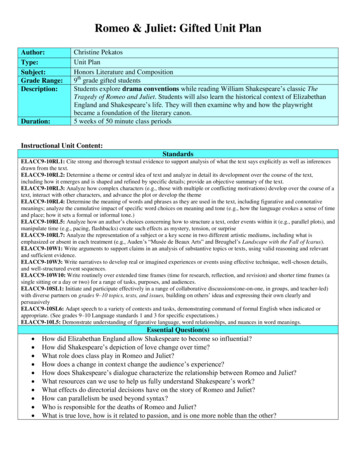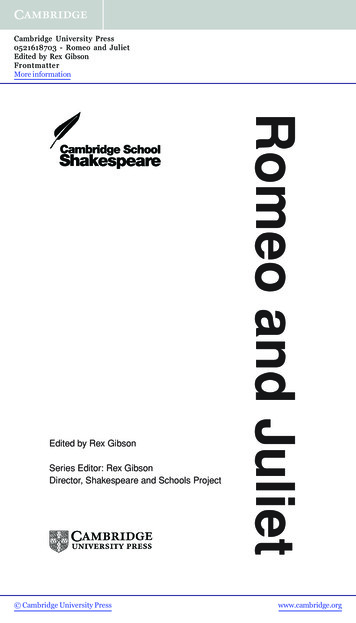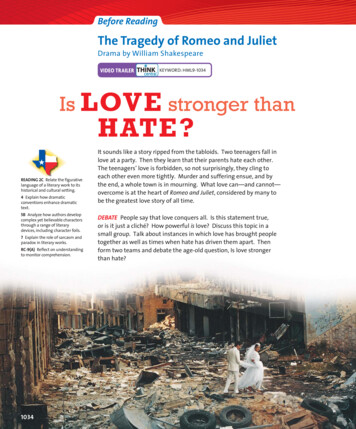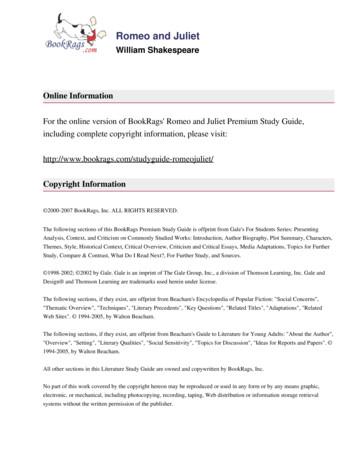
Transcription
Romeo and JulietWilliam ShakespeareOnline InformationFor the online version of BookRags' Romeo and Juliet Premium Study Guide,including complete copyright information, please et/Copyright Information 2000-2007 BookRags, Inc. ALL RIGHTS RESERVED.The following sections of this BookRags Premium Study Guide is offprint from Gale's For Students Series: PresentingAnalysis, Context, and Criticism on Commonly Studied Works: Introduction, Author Biography, Plot Summary, Characters,Themes, Style, Historical Context, Critical Overview, Criticism and Critical Essays, Media Adaptations, Topics for FurtherStudy, Compare & Contrast, What Do I Read Next?, For Further Study, and Sources. 1998-2002; 2002 by Gale. Gale is an imprint of The Gale Group, Inc., a division of Thomson Learning, Inc. Gale andDesign and Thomson Learning are trademarks used herein under license.The following sections, if they exist, are offprint from Beacham's Encyclopedia of Popular Fiction: "Social Concerns","Thematic Overview", "Techniques", "Literary Precedents", "Key Questions", "Related Titles", "Adaptations", "RelatedWeb Sites". 1994-2005, by Walton Beacham.The following sections, if they exist, are offprint from Beacham's Guide to Literature for Young Adults: "About the Author","Overview", "Setting", "Literary Qualities", "Social Sensitivity", "Topics for Discussion", "Ideas for Reports and Papers". 1994-2005, by Walton Beacham.All other sections in this Literature Study Guide are owned and copywritten by BookRags, Inc.No part of this work covered by the copyright hereon may be reproduced or used in any form or by any means graphic,electronic, or mechanical, including photocopying, recording, taping, Web distribution or information storage retrievalsystems without the written permission of the publisher.
Table of ContentsIntroduction.1Author Biography.2Summary and Analysis.3Prologue to Act 1.3Act 1.3Prologue to Act 2.4Act 2.4Act 3.5Act 4.6Act 5.6Act 1, Prologue.8Act 1, Scene 1.9Act 1, Scene 2.12Act 1, Scene 3.14Act 1, Scene 4.16Act 1, Scene 5.17Act 2, Prologue.20i
Table of ContentsAct 2, Scene 1.21Act 2, Scene 2.22Act 2, Scene 3.24Act 2, Scene 4.25Act 2, Scene 5.27Act 2, Scene 6.28Act 3, Scene 1.29Act 3, Scene 2.31Act 3, Scene 3.32Act 3, Scene 4.34Act 3, Scene 5.35Act 4, Scene 1.37Act 4, Scene 2.39Act 4, Scene 3.40ii
Table of ContentsAct 4, Scene 4.41Act 4, Scene 5.42Act 5, Scene 1.43Act 5, Scene 2.44Act 5, Scene 8Attendants:.48Balthazar:.49Benvolio:.49Capulet (Lady Capulet):.50Capulet (Lord Capulet):.51Catling (Simon Catling):.52Chorus:.52Citizens of Verona:.52Clown:.53Escalus (Prince Escalus):.53Friar John:.54Friar Lawrence:.54Gentlemen of both houses:.54Gentlewomen of both houses:.55Gregory:.55iii
Table of ContentsCharactersGuards:.55John (Friar John):.55Juliet:.55Lady Capulet:.57Lady Montague:.57Lawrence (Friar Lawrence [in some editions, Laurence]):.58Maskers:.59Mercutio:.60Montague (Lady Montague):.61Montague (Lord Montague):.61Musicians:.62Nurse:.62Old Man:.63Page to otpan:.65Rebeck (Hugh st (James .69iv
Table of ContentsCharacter Studies.70Conclusion.72Themes.73The Power and Passion of Love and Hate.73The Individual versus Society.74The Problem of Time.74Fate and Forebodings.75Principal Topics.76Style.79Light and Dark Polarity Motif.79Shakespearean Tragedy.79Use of a Chorus.80Blank Verse.80Rhymed Verse.80Prose.81Historical Context.82The Renaissance.82Elizabethan and Jacobean Literature.83Modern Connections.84Critical Overview.86v
Table of ContentsCriticism.89Critical Essay #1.90Critical Essay #2.103Critical Essay #3.113Critical Essay #4.121Critical Essay #5.132Critical Essay #6.140Critical Essay #7.158Critical Essay #8.163Critical Essay #9.176Critical Essay #10.181Critical Essay #11.187Media Adaptations.192Topics for Further Study.193vi
Table of ContentsCompare and Contrast.194What Do I Read Next?.196Sources for Further Study.197Literary Commentary:.197Copyright Information.202vii
IntroductionThe exact year in which William Shakespeare wrote Romeo and Juliet is unknown,but it is definitely one of his earlier works, and one of only two tragedies written in theperiod from 1590 to 1595. The other tragedy, Titus Andronicus followed theconventions of Seneca and Marlowe, i.e., built around a single heroic figure, butRomeo and Juliet was innovatively different. The plot was based on afourteenth-century Italian short story, or novella, written by Matteo Bandello, thatincluded elements of history, tradition, romance, and fable. This story had been putinto verse form in 1562 by British poet Arthur Brooke. In Shakespeare's hands,fashionable elements of Elizabethan drama were inserted, certain characters weremagnified, and sensational scenes were added. In addition, Shakespeare surroundedthe innocent lovers with the mature bawdiness of other characters. In truth, the playwas experimental for its time, but it was well-received by contemporary audiencesand remained popular through the centuries. For a long time, critics tended todowngrade Romeo and Juliet in comparison to Shakespeare's later tragedies. But inthe twentieth century the play gained appreciation for its unique merits and became astandard of high school study and was produced in various media.Romeo and Juliet is as much about hate as love. The play opens with a scene ofconflict between the two feuding families and ends with their reconciliation.Nonetheless, the play is considered one of the greatest love stories of all time,complicated by the interplay of fate and repeated misfortune in timing. Thejuxtaposition of light and dark, the injection of comic moments, and the beauty of thelanguage of love further enhance the play and make it a classic for all time.Introduction1
Author BiographyWilliam Shakespeare was born to John and Mary Arden Shakespeare inStratford-on-Avon, in Warwickshire, England, on April 26, 1564 and died therefifty-two years later on April 23, 1616. This period was remarkable in British historyin that it was both the time of the Renaissance and the Elizabethan age (1558--1603).Shakespeare received a good classical education as a child, but he did not go on touniversity studies. In 1582, at age eighteen, he married Anne Hathaway. A daughter,Susanna, was born to them in 1583, and twins, Hamnet and Judith, in 1585.Shakespeare went to London to become an actor and playwright in 1588, the sameyear that the British navy defeated the Spanish Armada. From 1592 to 1598 hedevoted his talents mostly to chronicle histories (tragedies) and comedies, includingRomeo and Juliet. In 1594, he had become associated with a successful theatricaltroupe called the Lord Chamberlain's Men (later, under King James I, the King'sMen), and was eventually a prime shareholder and the principal playwright. In 1599,this company built the Globe Theater. However, Shakespeare also gained popularityas a poet for works such as Venus and Adonis and The Rape of Lucrece, both writtenabout his patron, the Earl of Southampton. A collection of Shakespeare's sonnets wasnot published until 1609, although his friends had been reading them for years. By1597, Shakespeare was prosperous enough to buy a large, handsome home in thecenter of Stratford, and he was soon recognized as England's greatest dramatist. From1601 to 1609, he wrote his great tragedies and romantic comedies. In 1610, he retiredto Stratford-on-Avon, but he continued to write and produced four more plays until hisdeath. In the four hundred years since, his reputation has not diminished. Althoughthere is continued debate about whether he actually wrote all the plays and verseattributed to him, nothing has ever proven otherwise. Consequently, the appreciationof his talent and genius has grown such that he is generally considered the greatestplaywright of all time.Author Biography2
Summary and AnalysisPrologue to Act 1The prologue tells the audience that this story will be about two prominent families ofVerona, Italy, whose ancient feud is erupting anew and that a "pair of star-cross'dlovers" from these families will end the violence by ending their own lives.Act 1In scene 1, Capulet servants, Sampson and Gregory, and Montague servants, Abrahamand Balthasar, start a street fight that is joined by Benvolio, a Montague relative, andTybalt a Capulet relative. Escalus, the Prince of Verona, learns about the fight andangrily decrees a death penalty for anyone caught in further feuding. Benvolio findsRomeo and learns that Romeo is forlorn because the girl he loves, Rosaline, will notreturn his affection because she has chosen to remain chaste. Benvolio advises Romeoto move on with his life and look at other girls. Romeo, however, is quite sure that hecannot forget Rosaline.Scene 2 opens with Lord Capulet being approached by Count Paris, a relative ofPrince Escalus, about marrying Capulet's daughter, Juliet. Capulet thinks Juliet is tooyoung to marry but agrees to let the two meet at a party he is hosting that night. Byaccident, Romeo and Benvolio find out about the party, and Benvolio encouragesRomeo to crash the party with him.It is in scene 3 that the audience meets the garrulous nurse and learns that Juliet is only14 years old. Lady Capulet discusses the idea of marriage to Paris with Juliet, who hasnot yet given marriage any thought, but she obediently agrees to consider the match.Summary and Analysis3
Scene 4 finds Mercutio, another relative of the prince, joining Romeo and Benvolioand other friends on their way to the party. Mercutio teases the lovesick Romeo byscoffing at love. As they reach the party, Romeo expresses a feeling of impendingdoom.Scene 5 takes place at the Capulet's party where a disguised Romeo spies Juliet andfalls instantly in love. Lady Capulet's nephew Tybalt discovers Romeo's presence butis prevented from attacking Romeo by Lord Capulet who does not want such adisturbance at his party. In a brief encounter with Romeo, Juliet too falls in love.Later, they each learn separately from the nurse the family identity of the other.Prologue to Act 2The chorus dramatizes the complications faced by both Romeo and Juliet in their lovefor one another but predicts that passion will lend them the power needed to betogether.Act 2In a very short scene 1, Benvolio and Mercutio try to find Romeo, who has climbed awall to hide in the Capulet orchard. His friends give up when Romeo will not respondto their calls.Scene 2 is the famous balcony scene in which, ignoring the danger, Romeo hopes for aglimpse of Juliet outside her window. Romeo overhears Juliet talk about her love forhim. He then approaches her, and, after declaring their love, the two decide to marry.Juliet promises to send Romeo a messenger in the morning to make plans for theirwedding.In scene 3, Romeo goes to see Friar Laurence to arrange the wedding. Friar Laurenceagrees to marry the two in hopes that their union will end the feud.Act 14
In scene 4, Romeo meets his friends Mercutio and Benvolio, who are discussing achallenge sent by Tybalt to Romeo. Juliet's messenger, the nurse, arrives and speaksprivately to Romeo. The wedding is set for later that day.In scene 5, the nurse returns to Juliet and, after much teasing to exasperate the eagerJuliet, she reveals her news. Juliet uses the excuse of going to confession to get toFriar Laurence's cell.A tiny scene 6 accomplishes the wedding of Romeo and Juliet.Act 3In scene 1, later that day, Benvolio and Mercutio encounter Tybalt and are alreadysparring with words when Romeo arrives. Tybalt attempts to provoke Romeo into afight, but Romeo will not fight because, although unknown to the others, he andTybalt are now relatives by marriage. Instead, Mercutio challenges Tybalt and is killedby a deceitful stab from Tybalt when Romeo tries to separate them. Tybalt flees andMercutio dies. Romeo is so enraged that he tracks down Tybalt and kills him.Benvolio urges Romeo to flee. Just then, Escalus arrives and banishes Romeo fromVerona.In scene 2, the Nurse tells Juliet that Romeo has killed Tybalt. Despite her intensegrief over Tybalt, Juliet's love for Romeo wins out, and she asks the Nurse to findRomeo.Scene 3 finds Romeo in Friar Laurence's cell. Romeo learns of the banishment orderand almost commits suicide when he realizes he may not be able to see Juliet again.However, the Nurse's arrival and the Friar's confidence that the crisis will blow over ifRomeo will just hide out in Mantua for a while encourages Romeo to go see Juliet.A brief scene 4 finds Capulet deciding that marrying Paris will soothe what CapuletAct 25
assumes is Juliet's grief over Tybalt's death. Capulet sets the wedding for three daysaway and instructs his wife to tell Juliet.Scene 5 takes place at dawn after Romeo and Juliet have spent the night together. Justafter their heart-wrenching farewell, Juliet's mother arrives and tells Juliet that she isto marry Paris. Juliet refuses, and a terrible fight with her parents ensues. The nursecounsels Juliet to forget Romeo and marry Paris. Feeling betrayed by all, Juliet makesanother excuse to see Friar Laurence.Act 4Scene 1 is back at Friar Laurence's, where he tells Juliet to take a potion that willcause her to appear dead until Romeo can come to rescue her and take her away withhim to Mantua.In scene 2, Juliet claims that she has repented of her disobedience and agrees to marryParis. Lord Capulet is so pleased, he moves up the wedding to the next morning.Scene 3 finds Juliet asking the nurse to leave her alone that night. She then worriesabout trusting the friar, but she takes the potion anyway.Scene 4 shows the whole Capulet household working through the night to prepare forthe wedding.In scene 5, the nurse finds Juliet apparently dead. The wedding preparations arechanged to those of a funeral.Act 5Scene 1 takes place in Mantua as Romeo's servant Balthasar arrives, bringing the newsof Juliet's death. Romeo decides to risk his own life by returning immediately toAct 36
Verona. He buys poison from an apothecary with the intent of dying beside Juliet.In scene 2, Friar Laurence learns that his letter to Romeo explaining Juliet's deceptionwas not received. His messenger, Friar John, was confined by quarantine. FriarLaurence sends another letter to Mantua and heads off to the Capulet burial chamberto be there when Juliet awakens.In the final scene, Paris goes to Juliet's tomb to mourn her but finds Romeo there andassumes that, as a Montague, Romeo is desecrating Juliet's grave. A fight ensues andParis is killed. Romeo places him beside Juliet, then takes the poison, kisses Juliet, anddies. Friar Laurence finally arrives, but Juliet awakens and sees Romeo. Upon hearingnoises, Friar Laurence runs away, but Juliet will not leave. Juliet kisses Romeo, stabsherself, and dies. The arriving guards find the bodies, send for the prince, and discoverthe friar in hiding. The prince, the Capulets and the Montagues all arrive, andBalthasar, Paris's page, and Friar Laurence explain everything. Escalus confronts thetwo families with the results of their feud and the two lords reconcile with promises tobuild gold statues to each other's lost child. The play concludes with the prince'sdeclaration:For never was there a story of more woeThan this of Juliet and her Romeo.Act 57
Act 1, PrologueAct 1, Prologue SummaryThe prologue tells exactly what is the play is going to be about. It explains that thereare two families that are feuding. The two lovers in this story are from opposinghouseholds. This raises two questions for the audience. The first is if Romeo andJuliet's deaths could have been avoided if their families had stopped their feud. Thesecond is will their deaths show the families that there has been enough bloodshed andmaybe help them find peace. The chorus begs the audience to stay and find out.Act 1, Prologue AnalysisMany plays in Shakespeare's time would start one or more acts with prologues to tellthe audience what is going to happen. Many people in Shakespeare's time wereilliterate. Therefore, playbills were ineffective and this was only way the people wouldknow what the play was about.Act 1, Prologue8
Act 1, Scene 1Act 1, Scene 1 SummaryThe scene begins with Sampson and Gregory of the house of Capulet talking to eachother. Sampson makes it clear that they are in a feud with the Montagues. Sampson isnot going to let them humiliate the Capulets anymore and he is willing to fight anyoneto let them know, even the women and the children. Gregory agrees that they are notgoing to let the Montagues get away with any more humiliation but he warns Sampsonthat the feud is between the men of both houses and not the women. Sampson makes itclear that he does not care whether a Montague is a woman or man; he will kill them.It is at this point that they come across Abram and Balthasar from the house ofMontague. Gregory and Sampson want to fight but they discuss how it they will haveto let the others draw first. Therefore, Gregory and Sampson walk past the otherstaunting them, trying to get them into a quarrel. Though they have been insulted, theother two men do not attack. Benvolio, a Montague, now happens upon the scene justas the two sides start to fight. Benvolio tries to stop the by stopping their swords withhis. Tybalt, a Capulet, enters the scene, sees Benvolio, and mistakes him for being inthe fight. Benvolio tries to tell him that he was
Scene 2 is the famous balcony scene in which, ignoring the danger, Romeo hopes for a glimpse of Juliet outside her window. Romeo overhears Juliet talk about her love for him. He then approaches her, and, after declaring their love, the two decide to marry. Juliet promises to send Romeo a messenger in the morning to make plans for their wedding.
